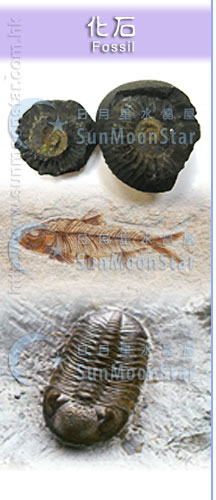Chinese Name :化石
English Name:Fossils
Astrological Sign :Virgo
Remarks:Fossils (from Latin fossus,
literally "having been dug up") are the preserved
remains or traces of animals (also known as zoolites), plants,
and other organisms from the remote past, the most common
is the bones and shells
The study of fossils across geological time, how they were
formed, and the evolutionary relationships between taxa (phylogeny)
are some of the most important functions of the science of
paleontology. Such a preserved specimen is called a "fossil"
if it is older than some minimum age,
most often the arbitrary
date of 10,000 years ago.
Hence, fossils range in age from the youngest at the start
of the Holocene Epoch to the oldest from the Archaean Eon,
up to 3.4 billion years old.
The observations that certain
fossils were associated with certain rock strata led early
geologists to recognize a geological timescale in the 19th
century.
The development of radiometric dating techniques
in the early 20th century allowed geologists to determine
the numerical or "absolute" age of the various strata
and thereby the included fossils.
Fossils found place:Most of the
fossils are in sedimentary rocks such as sandstone limestone
and found in shale, these rocks, usually in the earth's surface
exposure
Types of Fossil:
Fossils can be divided into 2 categories,
(1)
fossilized body parts (bones, claws, teeth, skin, embryos, etc.)
(2) fossilized traces, called incnofossils (which are footprints, nests, dung, toothmarks, etc.)
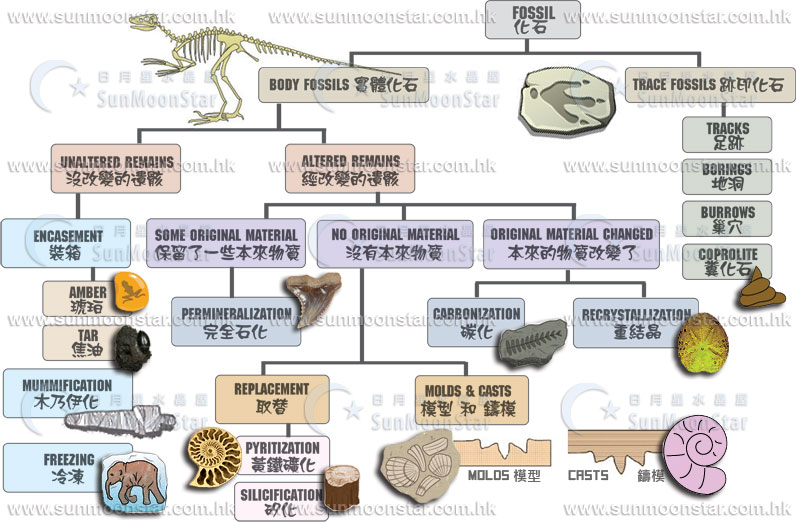
| Functions:In addition to the qualities listed for the mineral which assists in the fossiloization process, the following properties apply. |
| 1. |
Enhance telepathy power. |
| 2. |
Fossils are associated with the Earth element, which can heighten your intuition, especially when learning about crystals. |
| 3. |
It can be used in the treatment of disorders associated with the skeletal system, and the hands and feet. |
| 4. |
Revered by many cultures for centuries, Fossils, because of their age, are often used as talismans for protection and long life. |
| 5. |
Fossils will awaken interest in mysteries and releases mental obsessions. They have been known to normalise cell metabolism, energy output, heartbeat and fortifies the heart. |
| |
The different types of fossils include: |
| 1. |
The Oldest fossils ever discovered: Dated to around 3.7 billion years ago. Stromatolites |
| 2. |
Pyritized-fossils |
| 3. |
Petrified fossils |
| 4. |
Molds fossils |
| 5. |
Cast fossils |
| 6. |
Carbon films |
| 7. |
Preserved remains |
| 8. |
Trace Fossils |
| |
| 1. |
The Oldest fossils ever discovered. The earliest dated to around 3.7 billion years ago. |
| |
Stromatolites are layerd mounds, columns, and sheet-like sedimentary rocks that were originally formed by the growth of layer upon layer of cyanobacteria, a single-celled photosynthesizing microbe. |
| |
e.g. |
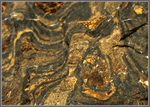 |
|
| |
|
Stromatolites |
|
| |
|
 |
 |
| |
|
Stromatolites: preserved mats of microorganisms sandwiched between layers of sediment. The earliset dated to around 3.7 billions years old. |
|
| |
| 2. |
Pyritization, Pyritized-fossils |
| |
Pyrite replacement of fossils is often caused by bacteria, in a process called permineralization. Since it requires both aerobic bacteria (which need oxygen to survive) and anaerobic bacteria (which live in places with little to no oxygen) to complete the process, pyritization can only occur in the levels of sediment near the interface between the two zones - and the sediment must have just the right amount of iron, not too much and not too little.
When the body of the unfortunate soon-to-be fossil is first buried, sulfate-reducing anaerobic bacteria begin to consume its organic material, producing sulfide.
The high concentration of iron in the sediment converts this to iron monosulfide, which is then oxidized into pyrite by aerobic bacteria. This pyrite is deposited onto the surfaces of the decaying organism, forming sparkly pyrite. |
| |
e.g. |
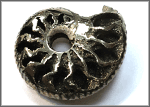 |
|
| |
|
Pyritized-fossils |
 |
| |
|
 |
|
| |
|
Pyrite replacing ammolite, keeping the outlook and sturcture of ammolite.
 |
|
| |
| 3 |
Silified fossils / Petrified fossils |
| |
Fossils often form when an organism's remains become petrified, or "turned into stone." In this process,
mineral-rich water soaks into the small cavities and pores of the original organ-ism. The minerals precipitate from the water and fill the spaces. |
| |
e.g. |
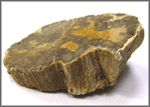 |
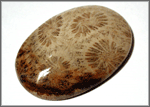 |
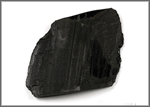 |
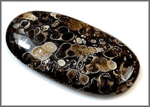 |
|
|
|
| |
|
Petrified Wood |
Coral Fossil |
Jet |
Elimia Tenera Fossil
Turritella Fossil |
 |
|
|
| |
|
 |
 |
 |
 |
 |
 |
|
| |
|
It is the result of a tree or tree-like plants having completely transitioned to stone by the process of permineralization.
 |
Fossil coral is a natural stone that is formed when ancient coral is gradually replaced with agate.
 |
Jet is the coalification of fossilisesd wood that comes from a family of tall everygreen cone bearing trees in South America and Australia that are ancient relatives of the pine tree. These deposits were created up to 180 million years ago.
 |
Elimia Tenera, formerly known as Goniobasis tenera, is an extinct species of freshwater snail with an operculum*, in the aquatic gastropod mollusk family Pleuroceridae.
*
Operculum is the "trap door" of the marine snail.

|
|
|
 |
| |
| 4. |
Molds fossils |
| |
(a fossilized impression made in the substrate - a negative image of the organism.)
A fossil mold is created when a shell or other structure is buried in sediment and then dissolved by underground water. The mold reflects only the shape and surface markings of the organism. It doesn't reveal any information about its internal sturcture.
|
| |
e.g. |
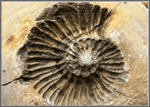 |
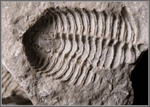 |
|
| |
|
Ammonite fossil |
Trilobite fossil |
 |
| |
|
 |
 |
|
| |
|
An ammonite is a fossilized, hard shell of an ancient, extinct mollusk.
 |
Contain 3 parts bending
sea shell creatures. 5.7 to 2.45 hundred millions ago, it's
the ancestor of crab and it's been extinguished. |
|
| |
| 5. |
Cast Fossils |
| |
(formed when a mold is filled in)
Cast fossils are created if the howllow spaces of a mold are later filled with mineral matter. |
| |
e.g. |
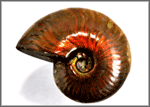 |
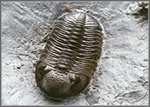 |
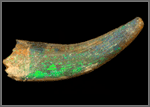 |
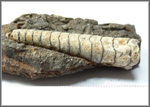 |
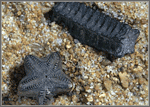 |
|
|
| |
|
Ammonite fossil (Ammolite) |
Trilobite fossil
 |
Opalised tooth fossil
 |
Orthoceras fossil |
Star Crinoids Fossil |
|
|
| |
|
 |
 |
|
 |
 |
|
|
| |
|
Ammolite is an opal-like organic gemstone found primarily along the eastern slopes of the Rocky Mountains of North America. (with attractive iridescence effect)
 |
Contain 3 parts bending
sea shell creatures. 5.7 to 2.45 hundred millions ago, it's
the ancestor of crab and it's been extinguished.
 |
teeth, which have turned to solid opal. Australia is the only country where opalised animal fossils are found.
 |
Orthoceras was an ancient mollusk that lived more than 400 million years ago and are the earliest recognizable animals. They are ancestors to the modern day squid. |
Crinoids are ancient fossil group that first appeared in the seas of the Middle Cambrian, about 300 million years before dinosaurs. Crinoids were not plants, but marine animals related to starfish and sea urchins. They lived in the anicent times but can still be found today. |
|
|
| |
| 6. |
Carbon films, also called carbonized fossils |
| |
Fossils called carbon films can preserve delicate details of leaves and animal parts. The formation of a carbon film begins when an organism is buried under the sediment.
Over time, pressure squeezes out liquids and gases and leaves behind a thin film of carbon. Black shale often contains carbon film fossils.
Look: Carbon film fossils are usually black, dark brown or light brown in colour, depending on the type of rock they are pressed upon.
Carbon film fossils are 2-dimensional, like a drawing. They preserve an enormous amount of detail, such as the leaves and veinsof a plant. Sometimes cells of the plant are even visible if the cells were filled with water.
|
| |
e.g. |
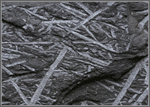 |
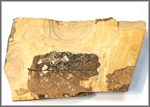 |
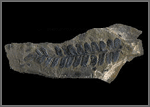 |
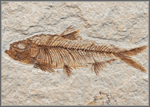 |
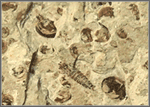 |
|
| |
|
Graptolites |
Plants fossil |
Fern fossil |
Fish fossil |
Shell fossil |
|
| |
|
|
 |
 |
 |
 |
|
| |
|
a fossil marine invertebrate animal of the Palaeozoic era, forming mainly planktonic colonies and believed to be related to the pterobranchs.

|
the preserved remains of plant life, mostly found embeded in sedimentary rocks, like shale, limestone and sandstone.
 |
Ferns are an ancient group of plants. By about 350 million years ago, ferns are seen in the fossil record. This makes ferns older than most land animals and far older than dinosaurs. |
Fish fossils are often carbon film.
The soft parts of its body decompose leaving the hard parts, like the skeleton.
 |
The name "ammonite", from which the scientific term is derived, was inspired by the spiral shape of their fossilized shells, which somewhat resemble tightly coiled rams' horns. |
|
| |
| 7. |
Preserved remains |
| |
Sometimes, fossilization preserves all or part of an organism with relatively little change. The mammoth frozen in permafrost is one example. Another example is insects preserved in amber - the hardened resin, or sap, of ancient trees. |
| |
e.g. |
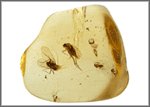 |
|
| |
|
insects preserved in amber |
|
| |
|
 |
 |
| |
|
Amber is a polymerized form fo tree resin that was produced by trees as a protection against disease agents and insect pests.The resin hardened, fossilized and become amber. |
|
| |
| 8. |
Trace fossils ( ichnofossils) |
| |
record the activities of organism. Tracks, burrows, eggshells, nests, tooth marks etc.
Trace fossils are indirect evidence of prehistoric life. tracks, are animal footprints made of soft sediment that later changed to sedimentary rock.
Burrows are holes made by an animal in sediment, wood, or rock that were later filled with mineral matter and preserved. |
| |
e.g. |
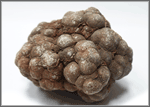 |
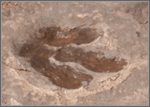 |
|
| |
|
Coprolites |
Dinosaur footprints |
 |
| |
|
 |
|
|
| |
|
a piece of fossil poop |
|
|
| There are six ways that organisms can turn into fossils, including: |
| 1. |
unaltered preservation (like insects or plants parts trapped in amber, a hardened form of tree sap) |
| 2. |
permineralization = petrification (in which rock-like minerals seep in slowly and replace the original organic tissues with silica, calcite or pyrite, forming a rock-like fossil - can preserve hard and soft parts - most bone and wood fossils are permineralized) |
| 3. |
replacement (An organism's hard parts dissolve and are replaced by other minerals, like calcite, silica, pyrite, or iron) |
| 4. |
carbonization = coalification (in which only the carbon remains in the specimen - other elements, like hydrogen, oxygen, and nitrogen are removed) |
| 5. |
recrystallization (hard parts either revert to more stable minerals or small crystals turn into larger crystals) |
| 6. |
authigenic preservation (molds and casts of organisms that have been destroyed or dissolved) |
|

 VIEW PRODUCTS
VIEW PRODUCTS
ONLINE |
|
